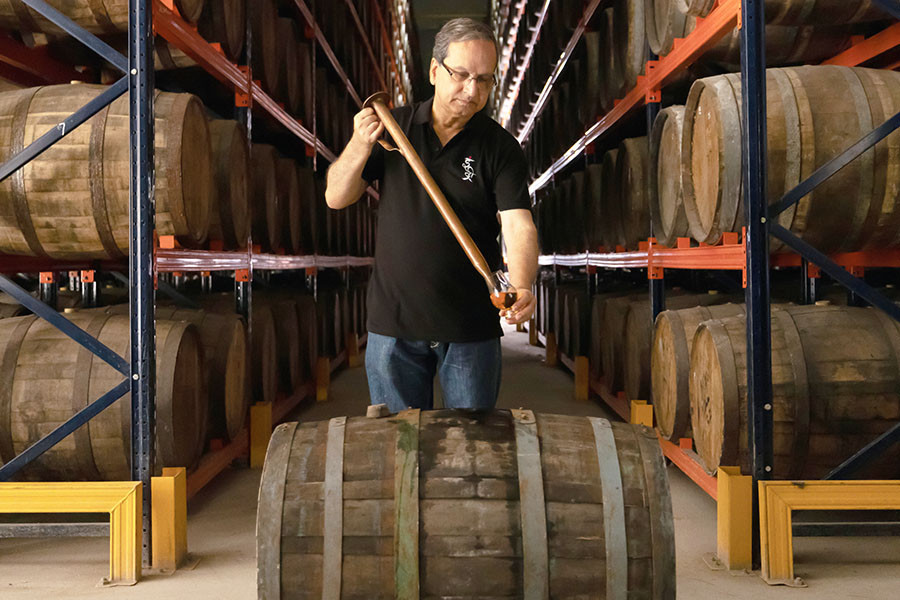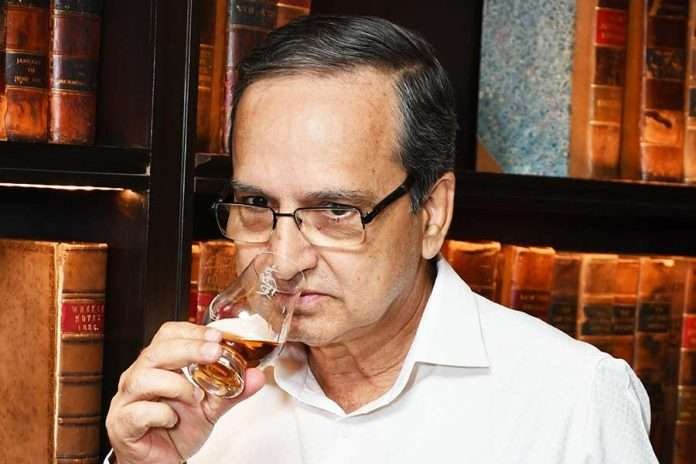In the world of spirits, Indri Whisky stands as a masterpiece, described as a “symphony of flavors” by its creators, Piccadily Distilleries. Blended in the heart of Haryana, this exceptional Indian whisky achieved a remarkable feat by clinching the ‘Best in Show, Double Gold’ award at the prestigious Whiskies of the World Awards 2023, surpassing more than 100 varieties of whiskies from around the globe, including Scotch, bourbon, Canadian, Australian, and British single malts.
In an exclusive interview with Forbes India, Surrinder Kumar, the master blender and distiller at Piccadily Distilleries, and a recognized name in the world of Indian single malts, shares insights about his journey in the alcohol and beverage industry, the art of blending, and the unique attributes that set Indri Whisky apart.
Q. How did you start your journey in the alco-bev industry?
Kumar’s journey in the alcohol and beverage industry began in 1986 when he had the privilege of being selected by Central Distilleries & Breweries, now a unit of United Spirits. This pivotal moment in his career allowed him to accumulate invaluable experience and make significant contributions to the production and development of spirits and alcoholic beverages. Reflecting on his over 35 years in the profession, Kumar describes it as a surreal experience.
Q. How did you learn the art of blending?
Kumar holds a master’s degree in food technology from the Central Food Technological Research Institute in Mysore, renowned as a premier institution for food technology in Southeast Asia. This educational foundation equipped him with the scientific principles and methodologies essential for beverage production. These skills prove invaluable in the intricate world of whisky blending, merging scientific precision with artistic finesse.
Q. What sets Indri Whisky apart?
Indri Whisky distinguishes itself as India’s first triple-cask single malt, bottled at 42.8 percent abv. It undergoes maturation in three coveted casks—ex-bourbon, ex-French wine, and PX Sherry. This triple-cask approach imparts a unique taste to the spirit, characterized by light fruity notes with sweet vanilla and spice, subtle nuttiness, and a reasonably long finish. The whisky boasts a smooth texture, a deep amber hue, and tantalizing flavors of caramelized pineapple, vanilla, black tea, raisins, honey, and a lingering sweet fruity aftertaste.

Q. What is your work process and inspiration?
Kumar plays a pivotal role in overseeing the entire production process, from malt plant operations to the sensory evaluation of the new make. He emphasizes the importance of maintaining the desired quality and character of the spirits. Kumar’s work also includes barrel sampling for whisky blends and single malts, an exciting task that allows him to assess maturation progress, flavor profiles, and overall quality. The creation of new products requires a deep understanding of market trends, consumer preferences, and the willingness to experiment with different ingredients and aging techniques. Kumar attributes his inspiration to his older brother, who instilled values of discipline, passion, and diligent execution. He fondly recalls how his brother took pride in his achievements, which has fueled his professional journey.
Q. Do you have a favorite whisky?
Kumar finds it challenging to choose a favorite whisky, but the GlenAllachie 2006 Single Cask 14-Year-Old holds a special place due to its unique characteristics and maturation process. In the Indian whisky segment, his preference naturally leans towards Indri, especially the peated variant, Indri Diwali Collector’s Edition 2023, known for its captivating smoky notes and a plethora of flavors.
Q. Do you have role models in your industry?
Kumar draws inspiration from distilleries worldwide that have mastered the art of distillation, paying meticulous attention to detail and using the finest ingredients. These distilleries have set a benchmark in the industry, inspiring him to create distinctive and exceptional whiskies.
Q. How do you view the competition for Indri in India, with the likes of Amrut, GianChand, Rampur, and Paul John?
Kumar sees competition as a driving force for innovation and quality improvement in the whisky market. He believes that these brands, including Indri, are collectively elevating Indian whiskies to a global stage. With over 14 prestigious global recognitions and recent accolades, Indri is ahead of the curve, signifying a promising future.
Q. How are the whiskies of North and South India different?
Both North and South India contribute to the rich tapestry of Indian whisky, offering distinct options for enthusiasts. Northern India’s climate leads to rapid aging, resulting in bold and robust characteristics, while the cooler, more humid South Indian climate yields mellow and nuanced flavors. Preferences, in the end, come down to personal taste.
Q. How do Indian single malts compare with those from countries like Scotland?
Kumar highlights the influence of climate on whisky maturation. Indian whiskies mature in extreme temperature variations, allowing for pronounced interaction between wood and whisky. This climate accelerates flavor development, making it unfair to compare Indian single malts with Scotch of the same age. According to Kumar, one year in India is equivalent to three years in Scotland in terms of maturation.
Q. What is the future of Indian single malts?
Kumar anticipates substantial growth in the Indian whisky sector, with Indian single malts projected to increase by nearly 30 percent annually. With innovative offerings and a growing enthusiast base, Indian single malts are poised for remarkable success, both domestically and globally.













